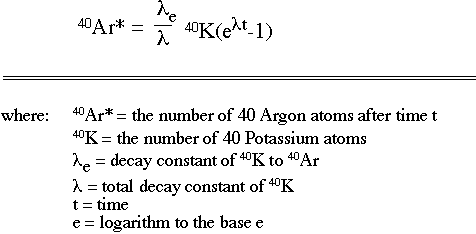K-ar dating limitations
Both techniques rely on the measurement of a daughter isotope 40 Ar and a parent isotope. Because the relative abundances of the potassium isotopes are known, the 39 Ar K produced from 39 K by a fast neutron reaction can be used as a proxy for potassium. Instead, the ratios of the different argon isotopes are measured, yielding more precise and accurate results. The amount of 39 Ar K produced in any given irradiation will be dependant on the amount of 39 K present initially, the length of the irradiation, the neutron flux density and the neutron capture cross section for 39 K.
However, because each of these parameters is difficult to determine independantly, a mineral standard, or monitor, of known age is irradiated with the samples of unknown age. The monitor flux can then be extrapolated to the samples, thereby determining their flux. This flux is known as the 'J' and can be determined by the following equation:.
Navigation menu
In addition to 39 Ar production from 39 K, several other 'interference' reactions occur during irradiation of the samples. Other isotopes of argon are produced from potassium, calcium, argon and chlorine. As the table above illustrates, several "undesirable" reactions occur on isotopes present within every geologic sample. These reactor produced isotopes of argon must be corrected for in order to determine an accurate age. The monitoring of the interfering reactions is performed through the use of laboratory salts and glasses.
K/Ar Dating
For example, to determine the amount of reactor produced 40 Ar from 40 K, potassium-rich glass is irradiated with the samples. The desirable production of 38 Ar from 37Cl allows us to determine how much chlorine is present in our samples. Multiple argon extractions can be performed on a sample in several ways.
- Historical Geology/K-Ar dating.
- is katy perry dating someone new.
- K–Ar dating - Wikipedia!
- dating by type.
- .
- Potassium-Argon Dating!
- aries woman dating.
Step-heating is the most common way and involves either a furnace or a laser to uniformily heat the sample to evolve argon. The individual ages from each heating step are then graphically plotted on an age spectrum or an isochron. Mechanical crushing is also a technique capable of releasing argon from a single sample in multiple steps.
But consider what happens if the argon came from deep within the Earth, where it was formed by 40 K decay, and was then trapped in magma or transported into the rock by hydrothermal fluid. Finally, we must consider the possibility of argon loss.

When a rock undergoes metamorphism , some or all of its argon can be outgassed. If all the argon was lost, this would reset the K-Ar clock to zero, and dating the rock would give us the time of metamorphism ; and if we recognized the rock as metamorphic this would actually be quite useful. However, we cannot rely on all the argon being lost, and if it is not then when we apply K-Ar dating this will give us an essentially arbitrary date somewhere between the formation of the rock and the metamorphosis event.
For these reasons K-Ar dating has largely been superseded by Ar-Ar dating, which will be the subject of the next article. From Wikibooks, open books for an open world. Decay of 40 K [ edit ] 40 K potassium is rather a peculiar isotope, in that it can undergo decay in three different ways: K-Ar dating [ edit ] Potassium is chemically incorporated into common minerals, notably hornblende , biotite and potassium feldspar , which are component minerals of igneous rocks.
From the equation describing radioactive decay , we can derive the following equation: Limitations of K-Ar dating [ edit ] There are a number of problems with the method. Retrieved from " https: Views Read Edit View history. Ar—Ar dating is a similar technique which compares isotopic ratios from the same portion of the sample to avoid this problem.

Due to the long half-life , the technique is most applicable for dating minerals and rocks more than , years old. For shorter timescales, it is unlikely that enough 40 Ar will have had time to accumulate in order to be accurately measurable. K—Ar dating was instrumental in the development of the geomagnetic polarity time scale.
The Wikibook Historical Geology has a page on the topic of: Instead, the ratios of the different argon isotopes are measured, yielding more precise and accurate results. This page was last edited on 26 October , at K—Ar dating was instrumental in the development of the geomagnetic polarity time scale. In this case, 39 Ar may recoil out of a low-temperature, high-potassium mineral e.
One archeological application has been in bracketing the age of archeological deposits at Olduvai Gorge by dating lava flows above and below the deposits. In the K—Ar method was used by the Mars Curiosity rover to date a rock on the Martian surface, the first time a rock has been dated from its mineral ingredients while situated on another planet. From Wikipedia, the free encyclopedia.
K–Ar dating
National Nuclear Data Center. Retrieved 20 September Retrieved February 22, Retrieved from " https: Use dmy dates from May Views Read Edit View history.
This page was last edited on 11 December , at